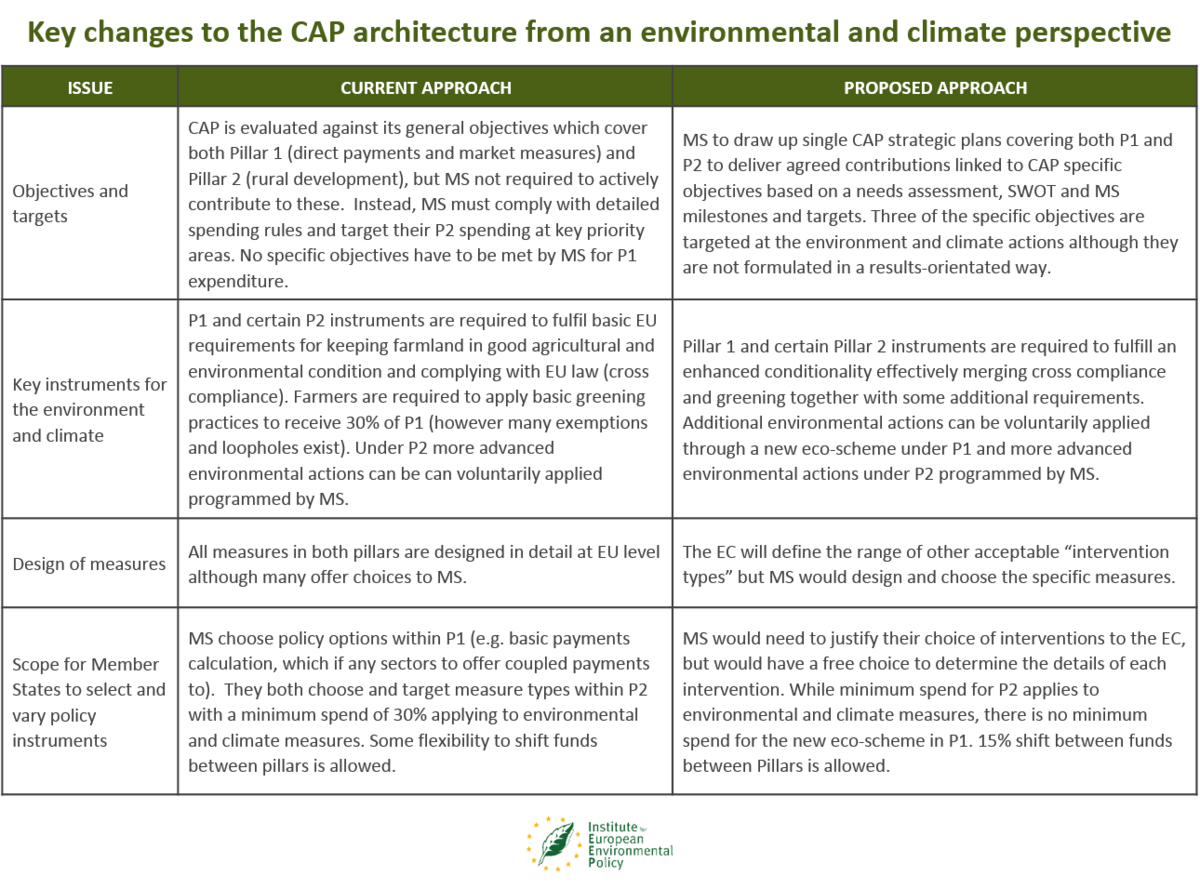Authors: Faustine Bas-Defossez, Stephen Meredith
Today the Commission launched its long awaited legislative proposal on the next Common Agricultural Policy (CAP) after 2020. This comes less than a month after the tabling of the EU’s Multiannual Financial Framework 2021-2027 which could see disproportionate cuts to Pillar 2 compared to Pillar 1.
The legislative proposals reaffirm the Commission’s stated intentions for next CAP to place greater emphasis on the environment and support the transition towards a fully sustainable agricultural sector through a new delivery model focused on results. Key environmental instruments include enhanced conditionality, a mandatory eco-scheme and the continuation of a minimum spend for the environment and climate under Pillar 2. While the new delivery model offers some potential to support a more environmentally ambitious CAP, it contains many loopholes which risk maintaining the status quo and does not set a clear direction of travel for the EU to comprehensively address the pressing sustainability challenges facing the sector and society. As the journey towards the adoption of the legislative texts is only beginning, there are still opportunities for the co-legislators to set the reformed CAP on a more sustainable track. Below we highlight some of the opportunities and risks in the proposal based on an initial assessment of the legislative text.
The proposed new delivery model is potentially a bold move to deliver more coherent, creative and innovative approaches to a performance based CAP that meets the needs of farmers, citizens and the environment. However, for the Member States to deliver a higher level of ambition for the environment and climate, CAP funds must be spent in a very different way. A recent evaluation on the greening of the CAP, conducted by IEEP on behalf of the Commission, shows that Member States tend not be very ambitious of their own accord. Similar findings are echoed by the European Court of Auditors. They also found that weak greening choices under Pillar 1 stiflled investment in more advanced environmental interventions under Pillar 2.
In terms of key instruments, the continued focus on direct payments, even with the redistribution proposed, leaves the bulk of CAP spending potentially unaligned to the ambitious delivery of public goods. The emphasis placed on these instruments appears not to fit with the logic of a results-orientated delivery model and continues a system that has been shown to be an inefficient, ineffective and inequitable way of supporting policy goals, including farmers’ incomes. Although the new “enhanced conditionality” decoupled payments introduces some welcomed additional components such as crop rotation and a farm nutrient management tool, it largely maintains the existing requirements and leaves a lot of discretion for the Member States to set the level of ambition. Aditionally such a tool does not signal the urgent need to lift the environmental performance of the CAP on a progressive basis as it remains largely based on static requirements.
On the other hand the mandatory proposed eco-scheme has the potential to reward and incentivise those farmers who wish to integrate and make a measurable contribution to meeting EU environmental and climate objectives and national targets as part of their farm enterprise. Unlike conditionality, support can address a wide range of environmental objectives based on continuous development with payments proportional to the level of ambition achieved. This could present a unique opportunity to pay farmers for the achievement of environmental and climate outcomes not fully remunerated by the majority market channels on a truly progressive basis – the more achieved, the more one could receive. However, for such an instrument to be effective it must be clearly targeted and adequately financed – with at least 30% of decoupled support ring-fenced for interventions that will enhance public goods delivery. It is also critical this measure does not turn into a substitute for higher levels of environmental ambition under Pillar 2 – especially at a time when spending on rural development programmes is expected to see sizeable cuts.
In the end for the new delivery model to increase environmental ambitious and not go back on what has already been achieved, a concrete set of results-orientated objectives grounded on meeting EU targets and international commitments and based around a common framework as well as ring-fenced spending for the environmental action in both Pillar 1 and 2 is critical. This must also be backed by strong accountability, the right level of engagement from stakeholders and robust monitoring of Member States’ performance and results’ achievements. These elements are necessary to ensure that the future design and monitoring of CAP Strategic Plans meets the Commission’s stated intentions and is not simply dependent on the political will of individual Member States. For instance, the omission of the CAP from the EU’s partnership agreement set out under the Common Provisions Regulation already raises concerns. All eyes will now on the co-legislators to make these new proposals meet the pressing environmental challenges facing the farming sector and society at large.
This initial assessment draws on a number of IEEP reports including:
- Evaluation study for the European Commission on the payment for agricultural practices beneficial for the climate and the environment (“greening” of direct payments) – report of the evaluator (Link)
- Report for WWF on ideas for defining environmental objectives and monitoring systems for a results-oriented CAP post 2020 (Link)
- Draft report for the European Parliament’s Agriculture and Rural Development Committee assessing the Commission’s plans for CAP reform as set out in November 2017 and the extent to which it address the CAP’s performance against its objectives – (Link)
Update 03 August 2018: A slightly updated IEEP assessment of the CAP legal proposal, submitted to the European Commission during its feedback period, is available to download below.
For press requests, please contact Harvey Jones at hjones@ieep.eu.

